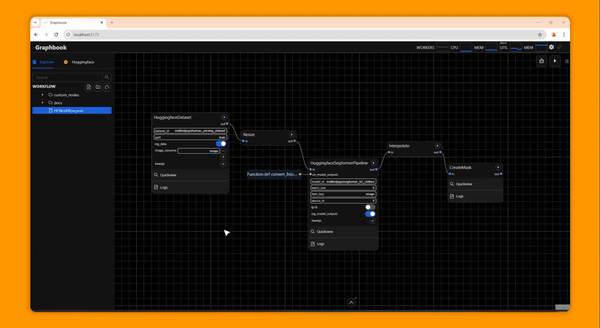Ecosyste.ms: Awesome
An open API service indexing awesome lists of open source software.
https://github.com/graphbookai/graphbook
The framework for AI-driven data pipelines. Build interactive, highly efficient data pipelines with PyTorch. ⭐ Leave a star to support us!
https://github.com/graphbookai/graphbook
ai data-processing data-processing-pipelines data-science framework machine-learning ml pytorch research workflow
Last synced: 3 months ago
JSON representation
The framework for AI-driven data pipelines. Build interactive, highly efficient data pipelines with PyTorch. ⭐ Leave a star to support us!
- Host: GitHub
- URL: https://github.com/graphbookai/graphbook
- Owner: graphbookai
- License: mit
- Created: 2024-04-18T01:50:57.000Z (10 months ago)
- Default Branch: main
- Last Pushed: 2024-11-29T15:42:11.000Z (3 months ago)
- Last Synced: 2024-11-29T16:35:16.628Z (3 months ago)
- Topics: ai, data-processing, data-processing-pipelines, data-science, framework, machine-learning, ml, pytorch, research, workflow
- Language: TypeScript
- Homepage: https://docs.graphbook.ai/
- Size: 1.21 MB
- Stars: 22
- Watchers: 2
- Forks: 1
- Open Issues: 7
-
Metadata Files:
- Readme: README.md
- Contributing: docs/contributing.rst
- License: LICENSE
Awesome Lists containing this project
README
Graphbook
The Framework for AI-driven Data Pipelines
Report bug
·
Request feature
Overview •
Status •
Getting Started •
Examples •
Collaboration
## Overview
Graphbook is a framework for building efficient, interactive DAG-structured AI data pipelines or workflows composed of nodes written in Python. Graphbook provides common ML processing features such as multiprocessing IO and automatic batching for PyTorch tensors, and it features a web-based UI to assemble, monitor, and execute data processing workflows. It can be used to prepare training data for custom ML models, experiment with custom trained or off-the-shelf models, and to build ML-based ETL applications. Custom nodes can be built in Python, and Graphbook will behave like a framework and call lifecycle methods on those nodes.
Build, run, monitor!
## Status
Graphbook is in a very early stage of development, so expect minor bugs and rapid design changes through the coming releases. If you would like to [report a bug](https://github.com/graphbookai/graphbook/issues/new?template=bug_report.md&labels=bug) or [request a feature](https://github.com/graphbookai/graphbook/issues/new?template=feature_request.md&labels=enhancement), please feel free to do so. We aim to make Graphbook serve our users in the best way possible.
### Current Features
- Graph-based visual editor to experiment and create complex ML workflows
- Caches outputs and only re-executes parts of the workflow that changes between executions
- UI monitoring components for logs and outputs per node
- Custom buildable nodes with Python via OOP and functional patterns
- Automatic batching for Pytorch tensors
- Multiprocessing I/O to and from disk and network
- Customizable multiprocessing functions
- Ability to execute entire graphs, or individual subgraphs/nodes
- Ability to execute singular batches of data
- Ability to pause graph execution
- Basic nodes for filtering, loading, and saving outputs
- Node grouping and subflows
- Autosaving and shareable serialized workflow files
- Registers node code changes without needing a restart
- Monitorable CPU and GPU resource usage
- Human-in-the-loop prompting for interactivity and manual control during DAG execution
- (BETA) Third Party Plugins *
\* We plan on adding documentation for the community to build plugins, but for now, an example can be seen at
[example_plugin](example_plugin) and
[graphbook-huggingface](https://github.com/graphbookai/graphbook-huggingface)
### Planned Features
- A `graphbook run` command to execute workflows in a CLI
- All-code workflows, so users never have to leave their IDE
- Remote subgraphs for scaling workflows on other Graphbook services
- And many optimizations for large data processing workloads
### Supported OS
The following operating systems are supported in order of most to least recommended:
- Linux
- Mac
- Windows (not recommended) *
\* There may be issues with running Graphbook on Windows. With limited resources, we can only focus testing and development on Linux.
## Getting Started
### Install from PyPI
1. `pip install graphbook`
1. `graphbook`
1. Visit http://localhost:8005
### Install with Docker
1. Pull and run the downloaded image
```bash
docker run --rm -p 8005:8005 -v $PWD/workflows:/app/workflows rsamf/graphbook:latest
```
1. Visit http://localhost:8005
### Recommended Plugins
* [Graphbook Hugging Face](https://github.com/graphbookai/graphbook-huggingface)
Visit the [docs](https://docs.graphbook.ai) to learn more on how to create custom nodes and workflows with Graphbook.
## Examples
We continually post examples of workflows and custom nodes in our [examples repo](https://github.com/graphbookai/graphbook-examples).
## Collaboration
Graphbook is in active development and very much welcomes contributors. This is a guide on how to run Graphbook in development mode. If you are simply using Graphbook, view the [Getting Started](#getting-started) section.
### Run Graphbook in Development Mode
You can use any other virtual environment solution, but it is highly adviced to use [poetry](https://python-poetry.org/docs/) since our dependencies are specified in poetry's format.
1. Clone the repo and `cd graphbook`
1. `poetry install --with dev`
1. `poetry shell`
1. `python graphbook/main.py`
1. `cd web`
1. `npm install`
1. `npm run dev`








